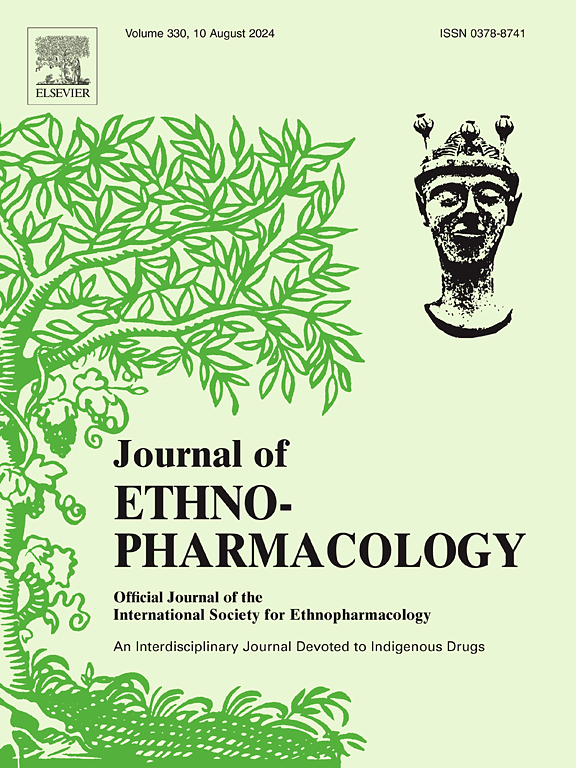木毛纤毛提取物调节氧化炎症反应:体外分析。
IF 4.8
2区 医学
Q1 CHEMISTRY, MEDICINAL
引用次数: 0
摘要
民族药理学相关性:属Meliaceae的植物,如Trichilia silvatica C. DC。,被称为catiguá-branco,由于其多样而重要的次生代谢物,引起了人们对植物化学研究的极大兴趣。传统上,巴西医学用林木毛纤毛虫来治疗炎症性疾病。此外,研究报道了其抗氧化和抗菌特性,突出了其潜在的治疗应用。研究目的:本研究旨在评估毛毛菌叶和茎提取物在暴露于脂多糖(LPS)或过氧化氢(H2O2)后对RAW264.7巨噬细胞氧化炎症的调节潜力,并阐明其潜在的作用机制。材料与方法:采用薄层色谱(TLC)、HPLC(反相Hypersil C-18色谱柱)和分光光度法对提取物的植物化学成分进行表征。采用2,2-异芬尼-1-吡咯肼(DPPH)和铁还原抗氧化能力(FRAP)测定其抗氧化活性。通过3-(4,5-二甲基噻唑-2-基)-2,5-二苯基溴化四唑(MTT)测定细胞活力,同时测定过氧化氢酶(CAT)和超氧化物歧化酶(SOD)酶活性,以及细胞中过氧化氢酶(CAT)和超氧化物歧化酶(SOD)的活性,然后用H2O2刺激细胞。RT-qPCR检测核κB因子(NF-κB)、环氧化酶2 (COX-2)、肿瘤坏死因子α (TNF-α)、白细胞介素10 (IL-10)、缺氧诱导因子-1 (HIF-1)的基因表达水平。结果:木毛纤毛提取物中含有萜烯/甾体、香豆素、缩合单宁和酚酸,包括绿原酸和咖啡酸。结果表明,100 μg/ml叶提取物、100 μg/ml茎提取物和250 μg/ml茎提取物均能保持或增强细胞活力,对h2o2诱导的氧化应激具有保护作用。这些浓度显著提高了CAT活性,而SOD活性未受影响。茎叶提取物分别为100 μg/ml和250 μg/ml时,细胞一氧化氮产量显著降低。此外,在250 μg/mL时,FRAP值显示抗氧化能力增加。在100 μg/mL和250 μg/mL浓度下,叶提取物和茎提取物对DPPH自由基的清除能力均超过75%,并下调促炎细胞因子NF-κB、TNF-α和COX-2的表达。250 μg/ml叶提取物和100 μg/ml茎提取物均上调IL-10和H1F1的表达。结论:上述结果表明,毛毛菌提取物具有显著的抗氧化活性,对DPPH自由基的抑制作用大于75%,FRAP值升高。此外,该提取物通过下调关键促炎介质TNF-α、NF-κB和COX-2,上调抗炎细胞素IL-10,并通过增加HIF-1的表达增强组织氧合和营养供应,显示出抗炎特性。这些作用突出了木犀草提取物作为治疗与氧化应激相关的炎症性疾病的治疗药物的潜力,从而支持了其传统的医学用途。本文章由计算机程序翻译,如有差异,请以英文原文为准。
Trichilia silvatica extracts modulate the oxinflammatory response: an in vitro analysis
Ethnopharmacological relevance
Plants belonging to the Meliaceae family, such as Trichilia silvatica C. DC., known as catiguá-branco, have attracted considerable interest in phytochemical research due to their diverse and significant secondary metabolites. Trichilia silvatica has traditionally been employed in Brazilian medicine to treat inflammatory disorders. Moreover, studies have reported its antioxidant and antimicrobial properties, highlighting its potential therapeutic applications.
Aim of the study
This study aimed to evaluate the potential of Trichilia silvatica leaf and stem extracts in modulating OxInflammation in RAW264.7 macrophage cells following exposure to lipopolysaccharide (LPS) or hydrogen peroxide (H2O2) and to elucidate the underlying mechanisms of action.
Material and methods
The phytochemical composition of the extracts was characterized using thin-layer chromatography (TLC), HPLC equipped with a reversed-phase Hypersil C-18 column, and spectrophotometric method. Their antioxidant activity was evaluated using the 2,2-difenil-1-picrilhidrazil (DPPH) and Ferric Reducing Antioxidant Power (FRAP) assays. Cell viability was assessed via the 3-(4,5-dimethylthiazol-2-yl)-2,5-diphenyltetrazolium bromide (MTT) assay, alongside the determination of catalase (CAT) and superoxide dismutase (SOD) enzyme activities, as well as nitric oxide (NO) production in cells treated with the extracts and subsequently stimulated with H2O2. Gene expression levels of Factor nuclear kappa B (NF-κB), Ciclooxygenase 2 (COX-2), Tumor necrosis factor alpha (TNF-α), Interleukin 10 (IL-10), and Hypoxia-inducible factor-1 (HIF-1) were quantified using RT-qPCR.
Results
Trichilia silvatica extracts revealed the presence of terpenes/steroids, coumarins, condensed tannins, and phenolic acids, including chlorogenic and caffeic acids. The findings indicate that the leaf extract at 100 μg/ml and the stem extract at 100 μg/ml and 250 μg/ml preserved or enhanced cell viability, conferring protection against H2O2-induced oxidative stress. These concentrations significantly increased CAT activity, whereas SOD activity remained unaffected. Nitric oxide production was significantly reduced when cells were treated with 100 μg/ml and 250 μg/ml of both leaf and stem extracts. Moreover, FRAP value revealed an increase in antioxidant capacity at 250 μg/mL. Both leaf and stem extracts, at 100 μg/mL and 250 μg/mL, exhibited a DPPH radical scavenging capacity exceeding 75 % and downregulated the expression of pro-inflammatory cytokines, including NF-κB, TNF-α, and COX-2. Notably, the leaf extract at 250 μg/ml and the stem extract at 100 μg/mL upregulated the expression of IL-10 and H1F1.
Conclusions
These findings indicate that Trichilia silvatica extracts exhibit notable antioxidant activity, as evidenced by greater than 75 % inhibition of DPPH radicals and elevated FRAP values. Additionally, the extracts demonstrated anti-inflammatory properties by downregulating key pro-inflammatory mediators, including TNF-α, NF-κB, and COX-2, while upregulating the anti-inflammatory cytoline IL-10 and enhancing enhancing tissue oxygenation and nutrient supply through increased expression of HIF-1. These effects highlight the potential of T. silvatica extracts as therapeutic agents for managing inflammatory diseases associated with oxidative stress, thereby supporting their traditional medicinal use.
求助全文
通过发布文献求助,成功后即可免费获取论文全文。
去求助
来源期刊

Journal of ethnopharmacology
医学-全科医学与补充医学
CiteScore
10.30
自引率
5.60%
发文量
967
审稿时长
77 days
期刊介绍:
The Journal of Ethnopharmacology is dedicated to the exchange of information and understandings about people''s use of plants, fungi, animals, microorganisms and minerals and their biological and pharmacological effects based on the principles established through international conventions. Early people confronted with illness and disease, discovered a wealth of useful therapeutic agents in the plant and animal kingdoms. The empirical knowledge of these medicinal substances and their toxic potential was passed on by oral tradition and sometimes recorded in herbals and other texts on materia medica. Many valuable drugs of today (e.g., atropine, ephedrine, tubocurarine, digoxin, reserpine) came into use through the study of indigenous remedies. Chemists continue to use plant-derived drugs (e.g., morphine, taxol, physostigmine, quinidine, emetine) as prototypes in their attempts to develop more effective and less toxic medicinals.
 求助内容:
求助内容: 应助结果提醒方式:
应助结果提醒方式:


